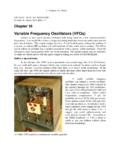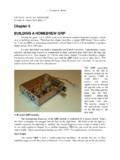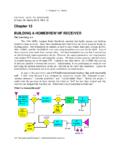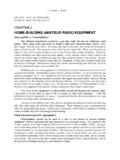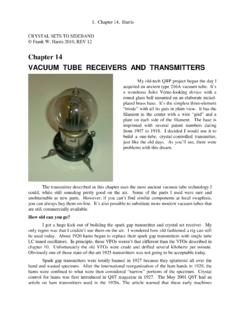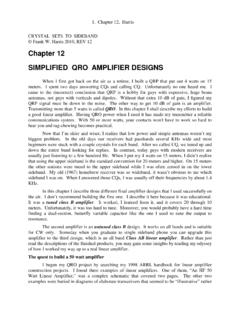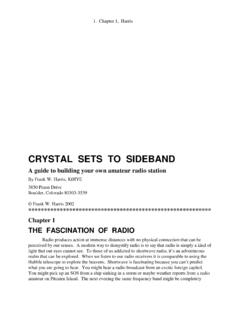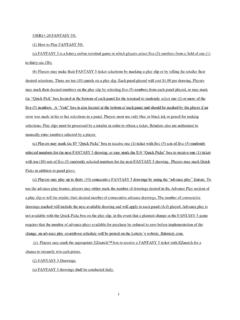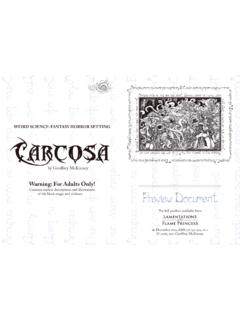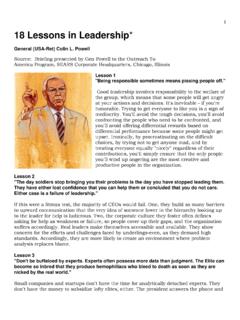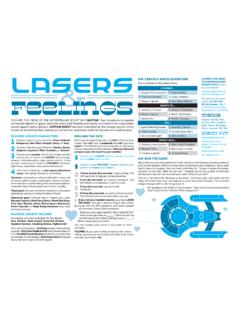Transcription of CHAPTER 5 GETTING ON THE AIR - QRP ARCI
1 1. CHAPTER 5, Harris CRYSTAL SETS TO SIDEBAND Frank W. Harris 2002 CHAPTER 5 GETTING ON THE AIR Deciding what to do first Earn an amateur license! If your going to build your own ham station, you will need an FCC license to transmit. Testing for licenses is conducted by hams in your local area. The simplest first step is to contact a ham in your area. He or she will tell you what to do. Failing that, contact the Amateur Radio Relay League, They will fix you up with study guides and point you to the nearest ham radio club where you can meet other hams and take your test.
2 Working on a license can be an interesting side project while you build your receiver and transmitter. Figuring out a plan for your station Most hams are content to buy one of those marvelous commercial transceivers. They plug it into the wall, put up an antenna and start talking. In contrast, a growing number of hams are building small, low power transmitters called QRP transmitters. QRP is an old Morse code abbreviation meaning turn down the power. In modern usage QRP means a transmitter delivering less than 5 watts of RF power. QRP guys are usually fellows who have been using commercial rigs for years and want to try something more adventurous and primitive.
3 Most QRP enthusiasts buy tiny transmitter kits with pre-printed and pre-drilled circuit boards. The assembly procedure consists of following a picture, plugging components into the correct holes and soldering the leads. These kits teach soldering technique and you learn what the components look like. Unfortunately, if the kit is well designed, it offers little chance to learn how the circuits work. A few hams start with a circuit from the ARRL handbook or QST magazine. Following the circuit diagram, they build their own version of the circuit out of individual components.
4 Their components are bought or scrounged one at a time and rarely exactly match the components used by the author of the article. A QRP like this usually doesn t work properly without sweat and rebuilding. This sounds like work, but the compensation is that now you re learning something! This kind of project is educational whether we planned on learning or not. Frustration, persistence and triumph is what ham radio used to be. rules of the game Scratch-building your own station is a kind of game. Our chief opponents are the amount of free time we have and modern frequency stability standards.
5 In my fantasy it would be neat to build all the components from raw materials and invent and design totally new circuits from scratch. Unfortunately, these tasks are too much for me. Rather, I use discrete parts I scrounge from junk and components I buy through catalogs or local stores. For circuit design I borrow circuit blocks from examples in the ARRL handbook and other sources. Then I assemble the circuit blocks into my project. 2. CHAPTER 5, Harris After I retired and had plenty of time, I got out my ARRL handbooks and studied plans for homebuilt receivers and transmitters.
6 I quickly encountered my other nemesis, integrated circuits: Tracing the circuit diagram of a typical modern receiver, one finds that the antenna is connected to a chip marked RF amplifier. Then the signal goes to another chip labeled mixer. The mixer receives a local oscillator signal from a large chip called a frequency synthesizer. The output from the mixer goes to a crystal filter sealed in a tiny metal can. Well, you get the idea. Modern radios are just block diagrams soldered onto printed circuit boards. I find that 1980 technology is usually a good compromise.
7 Few integrated circuits appear in the parts lists from that era. And if you re a purist, most of the integrated circuits can be replaced with discrete components. In summary, I try to use individual transistors and passive components exclusively. This teaches me how the circuit works and I can still build equipment that s reasonably modern. One compromise I have had to make was integrated circuit voltage regulators. In order to hold the frequency constant, the voltage supplied to the oscillators must be more stable than I know how to build using discrete parts.
8 Another compromise I ve made is the use of integrated circuit operational amplifiers. An operational amplifier is an array of transistors that functions as though it were a perfect transistor. It is usually easy to substitute real transistors, but you need to use many more of them to get the same performance. After a while I became bored making the same complex circuit again and again using discrete transistors. So, my rule is that, if I have proved I can build the equivalent of an integrated circuit with discrete parts, I feel I have earned the right to use a certain kind of integrated circuit.
9 My rules have taught me how the circuits work. I ve learned plenty. And by golly, when I m done, I really feel that I built it myself! Also, because I have struggled to understand it and make it work, I rarely have the feeling I am using magic. You don t have to use my rules . Make up your own! Planning your station A simple receiver and a QRP transmitter are a great start on a homebuilt station. (See Chapters 6 and 7) However, before you can go on the air with your transmitter, you will also need: A ham radio license. Contact local hams in your area or the American Radio Relay League in Newington, Connecticut.
10 (888) 277-5289. A 12 volt DC power supply for the QRP. ( CHAPTER 8.) An antenna (See end of this CHAPTER , CHAPTER 5) An antenna tuner ( CHAPTER 9) A telegraph key for Morse code. ( CHAPTER 9) Basic test equipment to ensure that your equipment is operating correctly. ( CHAPTER 9). Equipment for later on: A selective, sensitive all band hamband receiver ( CHAPTER 13) 3. CHAPTER 5, Harris A Class B or linear amplifier. ( CHAPTER 12) Although QRP is fun, you will probably eventually wish your signal were more powerful. With a loud signal more stations will hear you without a struggle and your contacts won t say 73 (good bye) so quickly.
